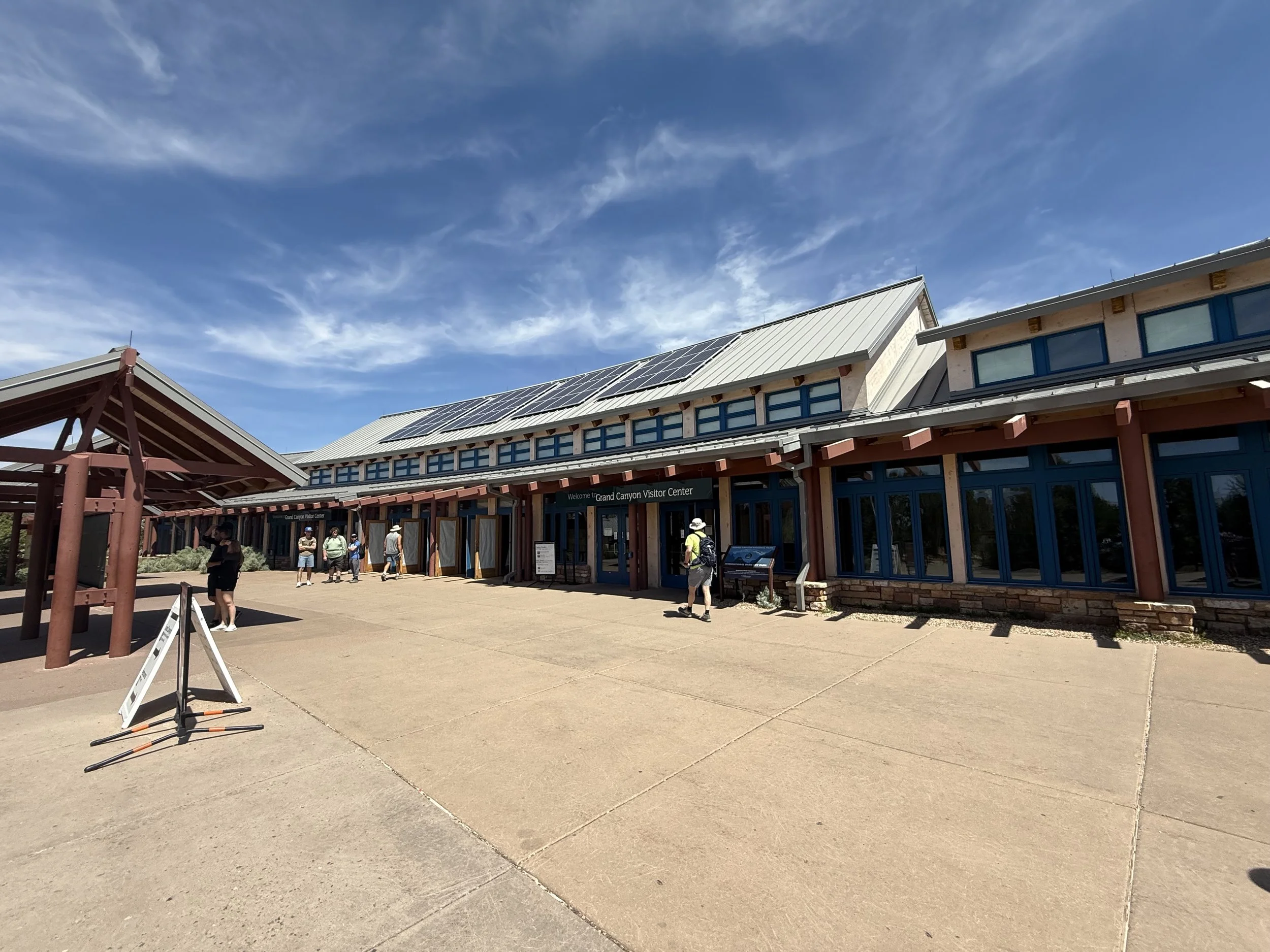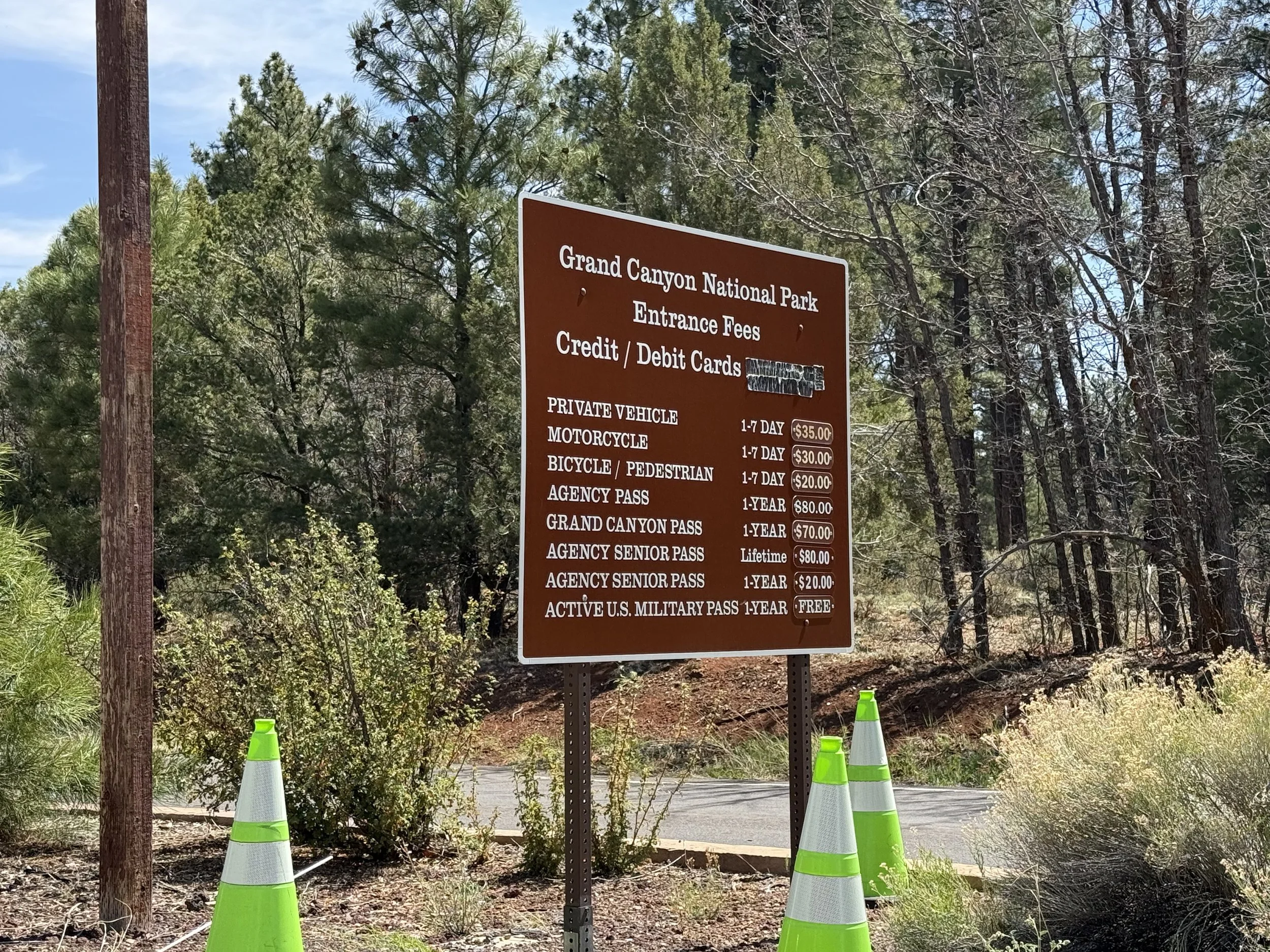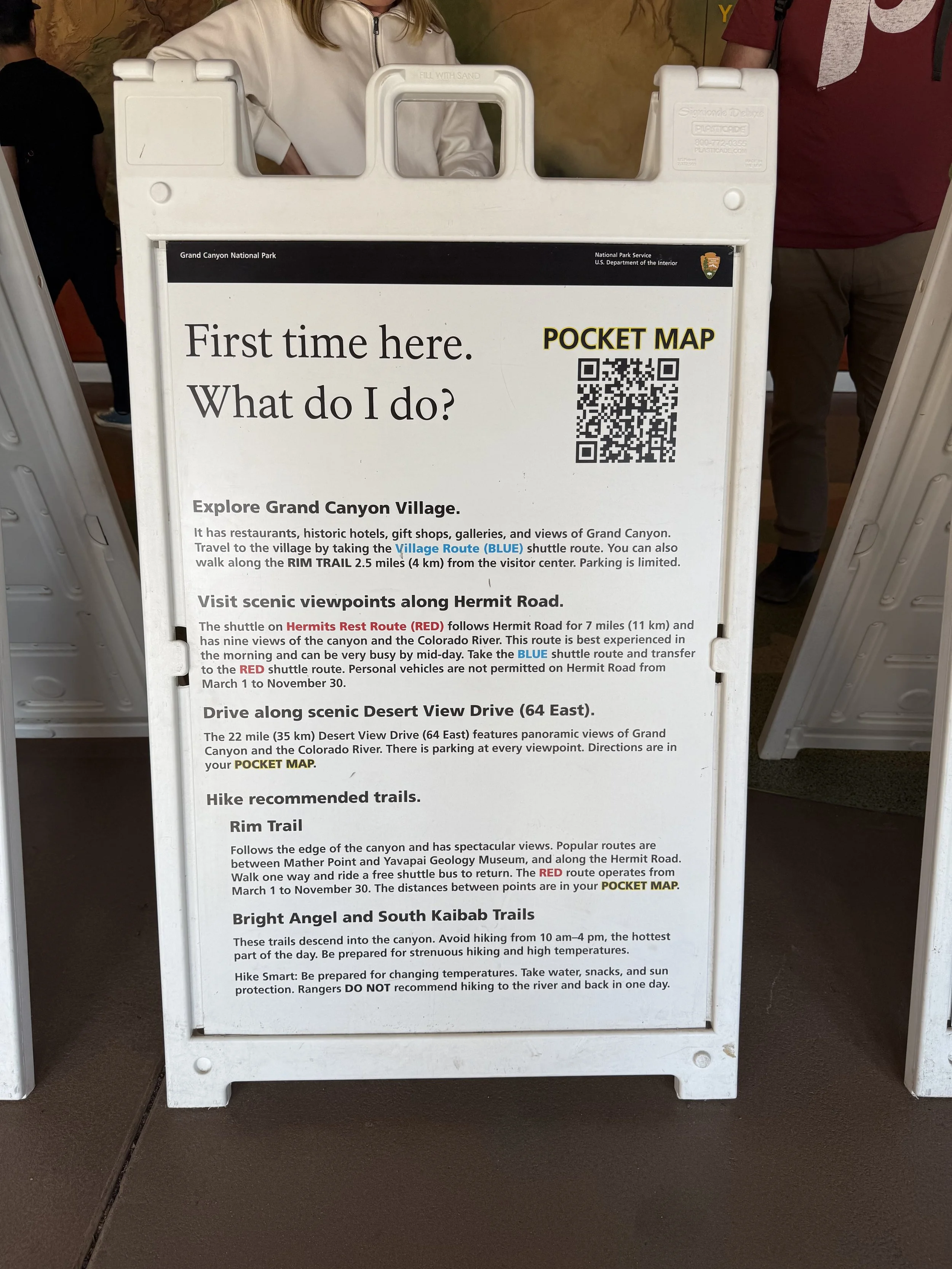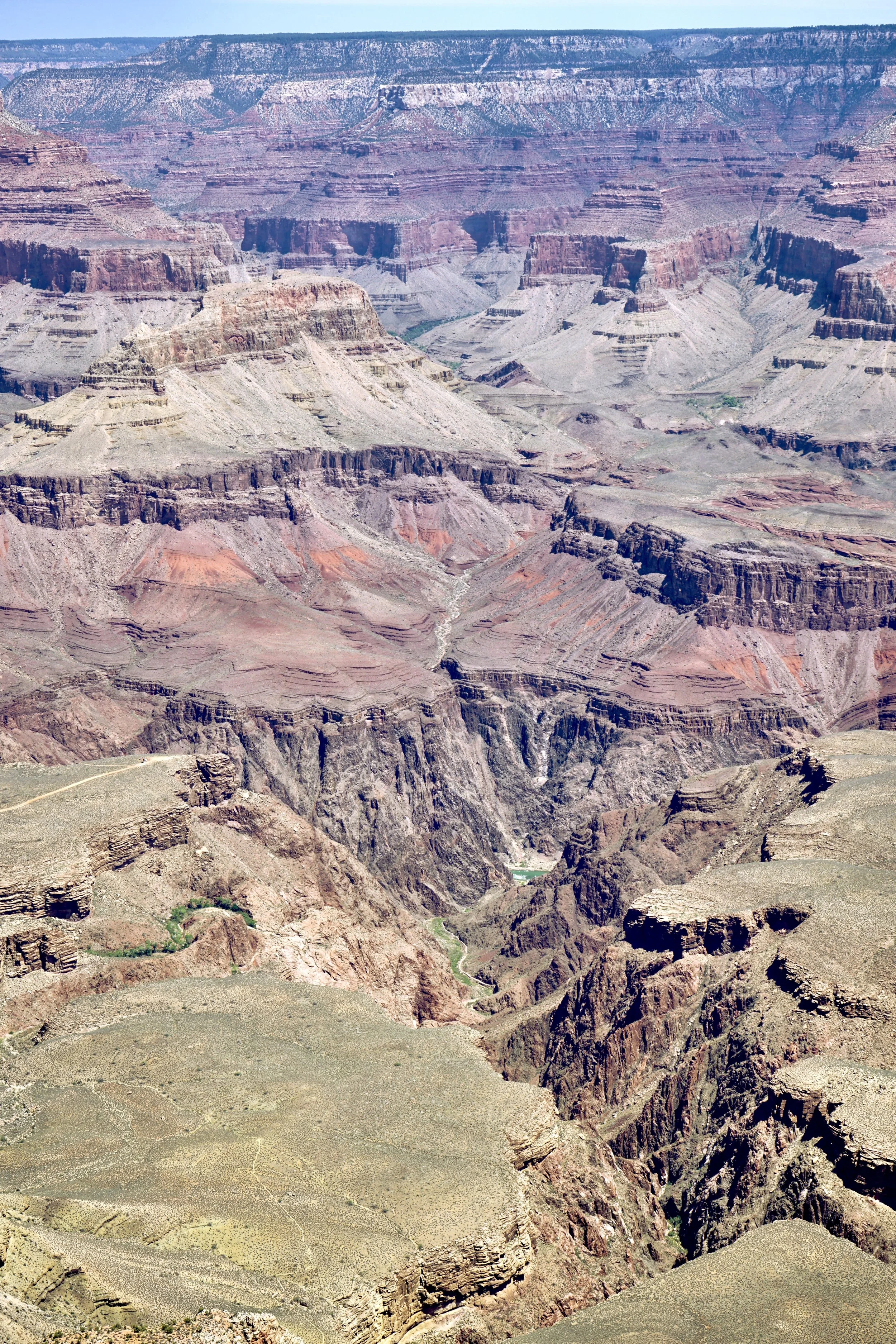#27 Grand Canyon National Park, Arizona
Grand Canyon from the South Rim
My trip to Grand Canyon National Park started with a simple question: Which rim should I visit? North, South, or West?
Each rim offers its own unique perspective. The South Rim is the most popular, with the largest visitor center and the most developed infrastructure. The West Rim, located on Hualapai tribal land, is home to the famous glass Skywalk — the see-through observation deck you’ve probably seen in photos. The North Rim is less visited but, from what I hear, offers some of the most breathtaking views (it’s also only open seasonally).
After weighing my options, I decided on the South Rim. Once that was set, I hit the road out of Las Vegas and headed toward Arizona. The drive takes about 3.5 to 4 hours — all classic desert scenery, with wide-open views, rocky landscapes, and that distinctive dusty palette.
I knew I was getting close when the traffic suddenly backed up. After miles of open highway, I found myself in a long, crawling line of cars approaching the South Entrance. Signs along the roadside gave rough wait-time estimates from each point, which helped set expectations.
While we were inching forward, I spotted the iconic Grand Canyon National Park entrance sign. Since I was traveling with my dad, I hopped out, handed him the driver’s seat, and jogged over to grab my usual sign photo. The line was moving so slowly that by the time I walked the short distance back — maybe 20 feet — the car had barely advanced.
Thankfully, all three entrance gates were open, which helped keep traffic flowing once we got to the front. We presented our America the Beautiful pass (which saved us the $35 vehicle fee) and headed into the park.
The South Rim has several large parking lots, but thanks to its popularity, most were full — and this was just a regular Wednesday in May. I eventually found a spot in Lot 3 and walked over to the visitor center complex. I call it a complex because it’s made up of multiple buildings, each serving different functions.
Inside the visitor center, I made my way to the stamp station (you know I had to get my National Park Passport stamped), grabbed a few maps, and headed back outside. It was a beautiful but hot day, so I decided to keep the hiking light.
From the visitor center, it’s about a five-minute walk to the main observation area, where you get your first proper view of the canyon. And let me tell you — the Grand Canyon really is grand. Several walkways and viewing platforms let you take in the landscape from different angles, each one as jaw-dropping as the last.
Because my dad has some mobility limitations, we took advantage of the free park shuttle system. The shuttles loop through many of the popular stops, letting you hop on and off without worrying about parking or walking long distances. It was an easy and relaxed way to explore more of the park.
After the shuttle loop, we returned to the car for some off-the-map exploring. My dad took me to one of his favorite lesser-known spots — a quieter area with access right up to the canyon’s edge. No guardrails, no crowds — just you, the rock, and a very long drop if you’re not careful. Standing there, looking out over that vast expanse, was nothing short of awe-inspiring.
A Bit About Grand Canyon National Park
Grand Canyon National Park is a UNESCO World Heritage Site and one of the most iconic natural landmarks on Earth. Over millions of years, the Colorado River carved the 277-mile-long canyon, exposing colorful rock layers that span two billion years of geologic history.
The area was first protected as a forest reserve in 1893, became a national monument in 1908, and officially became a national park in 1919. Today, it draws more than 4.7 million visitors annually and remains one of the most photographed and visited sites in the U.S.
South Rim Visitor Center
Visitor Centers
📍 South Rim Visitor Center (Main Complex)
20 South Entrance Road, Grand Canyon Village, AZ 86023
• Hours: 8:00 AM – 6:00 PM (seasonal; check before visiting)
• Features: Park information desk, interactive exhibits, 20-minute park film, bookstore, outdoor plaza, restrooms, water refill stations, bicycle rentals, and access to Mather Point overlook
• Notes: This is the main hub for visitors, where you can get maps, current trail and shuttle information, and ranger advice.
📍 Yavapai Geology Museum
• Location: Yavapai Point
• Features: Detailed geologic displays explaining the canyon’s formation, panoramic canyon windows, and one of the best sunset viewpoints
• Hours: 8:00 AM – 6:00 PM (check seasonally)
📍 Verkamp’s Visitor Center
• Location: Grand Canyon Village (near El Tovar Hotel)
• Features: Historic building with cultural exhibits about Grand Canyon Village history, small bookstore, ranger talks
• Hours: 8:00 AM – 6:00 PM (seasonal)
📍 Desert View Visitor Center (East Entrance)
•Location: 25 miles east of Grand Canyon Village
•Features: Near Desert View Watchtower, offers park info, small shop, and spectacular views from the tower
•Hours: Varies; often closed in winter
Tip: The South Rim Visitor Center is the best place to start if you’re new to the park, want to use the shuttles, or need detailed hiking advice. That’s where I picked up my National Park Passport stamp and grabbed all the maps and info I needed.
Entrance Fees and Passes
• Private vehicle: $35 (valid 7 days)
• Motorcycle: $30
• Individual (foot/bike): $20
• Annual America the Beautiful Pass: $80 (unlimited entry to all U.S. national parks for a year)
Best Hikes and Things To Do
• Mather Point: A short, paved walk from the South Rim Visitor Center, offering iconic views
• Yavapai Point and Geology Museum: A great combo of views and educational exhibits
• Rim Trail: Stretching along the canyon edge, offering mostly flat, accessible paths with multiple viewpoints
• Bright Angel Trail: The most popular rim-to-canyon trail — even hiking just a short way down gives a new perspective
Multi-Day Hikes and Rafting Trips
If you’re feeling adventurous, the Grand Canyon offers much more than just rim views. For those ready to go deeper — literally — here’s what you need to know:
Hiking Into the Canyon
Most visitors stick to the rim or take short hikes partway down, but if you want to hike all the way to the Colorado River or spend a night below the rim, it’s a serious commitment. Popular multi-day trails include:
• Bright Angel Trail to Phantom Ranch — about 9.5 miles one way, with overnight lodging or camping at the bottom (reservations required, often booked up a year in advance).
• South Kaibab Trail to Bright Angel Trail loop — a challenging multi-day loop with no water sources along South Kaibab (you need to carry everything).
• Backcountry camping — requires a backcountry permit from the park, which is highly competitive and often requires applying months in advance.
Important: DO NOT attempt to hike down to the river and back in a single day — the elevation change, heat, and distance are extremely demanding, and the park strongly warns against it.
Rafting and Kayaking the Colorado River
If you’re dreaming of rafting or kayaking through the canyon, you’ll need to plan ahead:
• Commercial rafting trips — These are multi-day guided trips (ranging from 3 days to over 2 weeks) offered by authorized outfitters. They handle permits, gear, and logistics, and you can choose motorized or oar-powered rafts.
• Non-commercial (private) trips — For experienced boaters only. These require a permit through a weighted lottery system, often with years-long waitlists. You’ll need to bring your own gear and demonstrate river-running expertise.
• Day trips — The main Colorado River inside Grand Canyon doesn’t offer casual day rafting; for that, you’d look upstream at places like Glen Canyon or downstream at Lake Mead.
Important: Rafting the Colorado River through the Grand Canyon is a serious wilderness experience, with remote conditions, challenging rapids, and no cell service. Whether you go guided or private, be prepared for an unforgettable — but demanding — adventure.
Best Photo Spots
• Mather Point (sunrise or sunset)
• Yavapai Point (geology views)
• Desert View Watchtower (sweeping vistas)
• Hermit Road viewpoints (via shuttle, especially for sunset shots)
• And of course: the national park entrance sign!
Grand Canyon Shuttle
Accessibility
The South Rim is the most accessible part of the park, with paved paths, accessible restrooms, shuttle buses with lifts, and designated parking at major overlooks. Portions of the Rim Trail are wheelchair-friendly, but always double-check conditions at the visitor center, as some areas can be uneven.
Other Helpful Info
• Best time to visit: Spring (March–May) and fall (September–November) when temperatures are mild
• Weather: It can be very hot in summer and chilly in winter, even snowing at times — dress in layers
• Food and drink: Restaurants, cafés, and grocery stores are located in Grand Canyon Village; bring plenty of water regardless
• Wildlife: Watch for elk, mule deer, California condors, and other wildlife — but do not approach or feed them
• Safety: Many canyon edges are unguarded; exercise caution and supervise children closely







